
Online Traffic Management

Informing and directing road users is generally done by putting up signs and fences. Until a few years ago, there would often be signs saying “ignore sat nav”, but we now know that many road users still use their navigation systems when approaching roadworks. It is therefore wise to inform road users about road closures and diversions in a personalised manner as well – through navigation systems, social media and online platforms such as Google and Nu.nl
Online Traffic Management is the collective name for a set of our services that allows us to directly approach, inform and engage in dialogue with various target audiences, and analyse the results. The target audiences are travellers, visitors, local residents and commuters (both employers and employees). Our approach involves making as much use as possible of existing road authority facilities, such as call centres or existing social media channels. It is the perfect addition for you if you want to start reaching target audiences around roadworks, road closures and events.
Objectives that are met by Online Traffic Management:
- Directly and demonstrably reaching different target audiences around roadworks or events;
- Being able to directly manage the travel behaviour of these target audiences, for example by providing them with a different route;
- Providing travellers with dynamic and up-to-date information on what they will encounter on their journey;
- Collecting data on the use of diversion routes, the mood of the various target audiences and the degree to which they are following advice;
- Getting in touch with the different target audiences and receiving their feedback.
There are three phases in Online Traffic Management: Informing, Analysing and Guiding. Below is a description of what we do in each phase.
1. Informing
Reaching travellers and those living near roadworks is a challenge. Besides physical information boards on and around roadworks, it is also important to reach the target audiences through online channels. But how do you organise that? Thanks to our partnerships with Waze, Google and social media sites such as Facebook and LinkedIn, we can post on these platforms. This lets us target the right audience and provide them with the right, relevant messages. Thanks to the wide reach of these platforms, we can inform target audiences throughout Europe. In addition to sending messages, we can also have target audiences perform actions, such as downloading apps or clicking through to websites.
Our approach makes it possible to make the right selections based on specific groups (commuters, local residents, entrepreneurs, tourists, etc.), certain demographics (age, gender, interests, etc.) and location (using geofencing). Which channel we choose to use also plays a key role. Different target audiences are addressed through Facebook and Instagram than through LinkedIn. We can work with you to examine how to make the selection and design the campaign.
Channels we can use include:
- Waze – Waze Takeovers allow us to send Waze users a personal message including an image and a link to, say, a landing page.
- Google Ads – the Google search engine and Google’s extensive Display network (including Nu.nl) allow us to show messages to users.
- Facebook and Instagram – the advertising network of these platforms lets us inform users with targeted messages.
- LinkedIn this platform’s advertising network allows users to be informed with targeted messages.
These messages can then direct the target audience to landing pages where they can see additional information or request personal travel advice. We are happy to create and set up these landing pages.
2. Analysis
Waze, Google and other platform users create a lot of data themselves. We can help you to gain insight into all kinds of data streams, which will help you monitor flow and peak loads. For more information, please visit our Event Traffic Dashboard for events or Roadwork Traffic Dashboard for roadworks.
3. Management
Directing travellers to a certain area or road users away from a certain section of road is possible by using online tools. Do you want navigation systems to avoid certain roads? Do you want event visitors to be able to drive to a parking location in the way you had planned? A mix of tools means we can help you achieve this.
Working in partnership with the Dutch and Belgian Waze communities, we help enter the correct information into the most commonly used navigation systems. Examples include road closures, road prioritisation and the designation of certain areas as destination traffic. We can also provide real-time guidance to road users who are making their way to a particular destination. For more information, please visit Traffic Reportal and Waze Community.
If you would also like to guide travellers to a certain area in their choice of modalities, then the Mobility Portal is the answer. This destination planner shows the traveller at a glance how to get to a destination and which alternatives are available. By taking factors such as price, travel time or other incentives into account, travel behaviour can be influenced in a way that encourages using the optimum mix of modalities.
